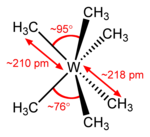Hexaméthyltungstène
| Hexaméthyltungstène | |
 | |
| Structure de l'hexaméthyltungstène | |
| Identification | |
|---|---|
| Nom UICPA | hexaméthyltungstène |
| Synonymes | [WMe6] |
| No CAS | 36133-73-0 |
| PubChem | 142049 |
| ChEBI | 30522 |
| SMILES | C[W](C)(C)(C)(C)C PubChem, vue 3D |
| InChI | Std. InChI : vue 3D InChI=1S/6CH3.W/h6*1H3; Std. InChIKey : XWAZCLPCQDERBK-UHFFFAOYSA-N |
| Propriétés chimiques | |
| Formule | C6H18W |
| Masse molaire[1] | 274,05 ± 0,02 g/mol C 26,3 %, H 6,62 %, W 67,08 %, |
| Unités du SI et CNTP, sauf indication contraire. | |
modifier  | |
L'hexaméthyltungstène est un composé organométallique de formule chimique W(CH3)6. Il s'agit d'un solide cristallisé rouge extrêmement volatil qui se sublime dès −30 °C. Il peut être conservé durablement à une température inférieure à −40 °C. Ses six groupes méthyle le rendent très soluble dans le pétrole, les hydrocarbures aromatiques, les éthers, le disulfure de carbone et le tétrachlorométhane[2],[3]. À une température inférieure à −25 °C, il peut demeurer en solution sans se décomposer significativement pendant plusieurs jours, solutions qui peuvent être utilisées pendant une courte période à température ambiante.
La préparation de l'hexaméthyltungstène en faisant réagir du méthyllithium CH3Li avec de l'hexachlorure de tungstène WCl6 dans l'éther diéthylique (C2H5)2O a été publiée en 1973[2]. Cette synthèse avait été motivée en partie par des travaux antérieurs qui indiquaient que les composés à géométrie tétraédrique métaux de transition méthylés étaient instables à la chaleur avec l'espoir qu'un composé octaédrique serait plus robuste. Une synthèse améliorée a été publiée en 1976 à partir du triméthylaluminium Al2(CH3)6 utilisé avec la triméthylamine N(CH3)3 à la place du méthyllithium[4] :
- WCl6 + 3 Al2(CH3)6 → W(CH3)6 + 6 Al(CH3)2Cl.
L'alkylation peut également être réalisée avec le diméthylzinc Zn(CH3)2[5] :
- WX6 + 3 Zn(CH3)2 → W(CH3)6 + 3 ZnX2 (X = F, Cl).
Notes et références
- ↑ Masse molaire calculée d’après « Atomic weights of the elements 2007 », sur www.chem.qmul.ac.uk.
- ↑ a et b (en) Anthony J. Shortland et Geoffrey Wilkinson, « Preparation and properties of hexamethyltungsten », Journal of the Chemical Society, Dalton Transactions, vol. 8, , p. 872-876 (DOI 10.1039/DT9730000872)
- ↑ (en) A. Koutsospyros, W. Braida, C. Christodoulatos, D. Dermatas et N. Strigul, « A review of tungsten: From environmental obscurity to scrutiny », Journal of Hazardous Materials, vol. 136, no 1, , p. 1–19 (PMID 16343746, DOI 10.1016/j.jhazmat.2005.11.007)
- ↑ (en) A. Lee Galyer et Geoffrey Wilkinson, « New synthesis of hexamethyltungsten(VI). The octamethyltungstate-(VI) lon », Journal of the Chemical Society, Dalton Transactions, vol. 21, , p. 2235-2238 (lire en ligne) DOI 10.1039/DT9760002235
- ↑ (en) Sven Kleinhenz, Valérie Pfennig et Konrad Seppelt, « Preparation and Structures of [W(CH3)6], [Re(CH3)6], [Nb(CH3)6]−, and [Ta(CH3)6]− », Chemistry - A European Journal, vol. 4, no 9, , p. 1687-1691 (lire en ligne) DOI 10.1002/(SICI)1521-3765(19980904)4:9<1687::AID-CHEM1687>3.0.CO;2-R
v · m | |||||
|---|---|---|---|---|---|
| W(0) |
| ||||
| W(II) |
| ||||
| W(III) |
| ||||
| W(IV) |
| ||||
| W(V) |
| ||||
| W(VI) |
| ||||
 Portail de la chimie
Portail de la chimie









